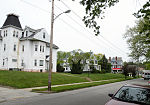East Washington Historic District

The East Washington Historic District is a historic district in East Washington, Pennsylvania that is listed on the National Register of Historic Places. It is designated as a historic district by the Washington County History & Landmarks Foundation.In 1984, the Washington County History and Landmarks Foundation succeeded in having a section of East Washington consisting of 120 Victorian houses added to the National Register of Historic Places. Washington & Jefferson College was opposed to the designation, but filed an objection too late in the proceedings. College President Howard J. Burnett said that the district "was structured to prevent expansion of the college." At issue was the college's plan to expand eastward towards the Wade Avenue area, a plan that was developed in the 1968 "Master Plan." Since then, the college has had a policy of purchasing homes in that area when they become available. The college has purchased and demolished a number of buildings listed in the historic district, including 308, 314 and 322 E. Wheeling Street, which made way for the Burnett Center. A 140-year-old farm house at 137 South Wade Street was acquired by the college in 1977 after being vacant for several years and moved to a new location. As of 1995, the college owned about 30 properties listed in the historic district.
Excerpt from the Wikipedia article East Washington Historic District (License: CC BY-SA 3.0, Authors, Images).East Washington Historic District
Hemlock Lane,
Geographical coordinates (GPS) Address Nearby Places Show on map
Geographical coordinates (GPS)
| Latitude | Longitude |
|---|---|
| N 40.171666666667 ° | E -80.234444444444 ° |
Address
Hemlock Lane 45
15301
Pennsylvania, United States
Open on Google Maps









